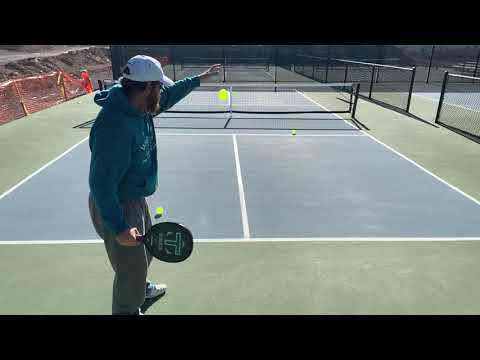
Pickleball in America is growing rapidly. If you're interested in playing it, there are some rules you should know. A team of two or three players wins most pickleball matches. This is a score of between 11 and 11. The team that wins the match will often be awarded prizes.
For starters, pickleball is played on a court that is 34 inches high at the center. The net measures 36 inches from the sides. Players must therefore stand either to the left or the right of the centerline. Each player must play on their respective side of pickleball court. The serving team must not be able to reach players who are standing on the kitchen or centerline of the pickleball court. The whole pickleball team must be available to play the game.
Pickleball players must wait for their partner before hitting their first serve. The return must be completed without touching the kitchen line. They should instead volley it. They can bounce the ball before they hit their return, but the server should call out the score if they do.

A double hit is achieved when the player hits the ball with a downstroke and contacts below the waist. An upward arc should also be achieved. But, a double hit is not possible if the shot is intentional.
Pickleball is best played with four players. But, you can play it with two. The first serve is for the starting team. After that, each side has the right to serve at any time. For rallies, the serving team may switch sides. The serving team must take their place if they lose their rally.
Besides, the double-bounce rule ensures that the serving team does not gain an advantage. The ball must bounce one time on each side. When the server hits a ball with an underhand stroke to the court, the arm must move in an upward arc.
It is crucial to keep track your score. It is particularly difficult for novice players keep track their scores. Even experienced players sometimes have trouble keeping score. You can ask an official to correct the score. The third shot can be challenged.

A "Dink", which is a defensive shot, is given to a player or team if a point has been scored. It's a good thing for the receiver team, as they have the opportunity to retaliate. The opposing team can earn a point if the receiver fails to defend.
Pickleball can be easy to learn, but it can be hard to remember all of the rules. Pickleball rules can be complicated and difficult to understand for recreational players.
FAQ
What effects does caffeine have on my sleep patterns?
Caffeine influences how quickly and how well you fall asleep. Caffeine causes drowsiness, which makes falling asleep easier. Caffeine keeps you awake for longer periods of time, making it difficult to fall asleep again. Instead of drinking coffee or energy drinks just before bed, you might consider having them in the evening.
How many hours of sleep should I get every night?
The recommended sleep amount varies based on age, gender, individual needs, and other factors. Adults need between 7 to 9 hours sleep each night. Teenagers and children typically need about 10 hours of sleep per night, but this number decreases as they grow older.
Are there any exercises I shouldn't do?
Before beginning any new workout program, consult your doctor. Some people have injuries or medical conditions that prevent them from doing certain types of exercise. Some activities may require special equipment, or training. Swimming, for example requires a swimming suit and access to the water.
Can I exercise after eating?
It depends on the exercise you do. Avoid strenuous exercises after meals. It could cause stomach cramps. Light aerobic activities such brisk biking and walking are better.
Is it possible for one to be too thin?
Yes! Both being underweight and having an eating disorder can be dangerous. It's normal to be a little heavier than you should be. It is possible to feel tired, weak or dizzy and may experience other signs that you are underweight.
Which Is Most Important: Diet, Exercise, or Sleep?
What you are looking to accomplish will determine the answer. Diet is key to losing weight. For building muscle mass, exercise is key. The last factor is sleep, which only impacts how well you perform during your day.
How do I get started with Fitness?
Start small. Try taking 10 minutes each day to walk around the block. This will teach you the basics of movement and give your muscles time for adaptation. Once you've mastered this simple form of exercise, try adding more steps to your daily routine.
Statistics
- In high-income countries, 26% of men and 35% of women were insufficiently physically active, as compared to 12% of men and 24% of women in low-income countries. (who.int)
- In 2018, the World Health Assembly agreed on a global target to reduce physical inactivity by 15% by 2030 and align with the Sustainable Development Goals. (who.int)
- An estimated 110,000 deaths per year could be prevented (cdc.gov)
- Physical activity confers the following maternal and fetal health benefits: a decreased risk of pre-eclampsia, gestational hypertension, gestational diabetes (for example, 30% reduction in risk) (who.int)
External Links
How To
How to Burn Belly Fats Faster
Belly Fat is often considered a problem for those who want to lose weight. If you look at it, belly fat is actually a positive thing. Your organs are protected from being damaged by excess belly fat. Let's find out how to lose belly fat quickly.
Stress and inactivity are two of the major factors that cause us to store body fat. Because stress stimulates the release of cortisol hormone, it makes us hungry all the time. Cortisol can increase insulin levels in the blood. The insulin then stores extra calories as fat. An increased appetite can be caused by a lack of sleep. These extra calories can easily be lost through exercise.
There are many different ways to reduce bellyfat. You can choose to try any of these options, depending on your budget. Here are some quick tips to get rid of belly weight.
-
Try to eat less food. You should eat smaller meals throughout the day than you would if you ate three big meals. This will result in fewer calories.
-
Drink plenty of fluids. Water flushes out toxins from your body and keeps you hydrated. You won't overeat if you drink water before you eat.
-
Avoid unhealthy snacks. If you're looking for quick fixes, snack foods like chips, cookies, candies, etc. This might be tempting. These fattening treats are best avoided as they have too many empty calories and sugar. Instead, choose healthy alternatives like fruits, veggies, nuts, seeds, and whole grains.
-
Strength training should be done at least three times per week. Strength training builds muscle mass and burns more calories when you're not working out. Strengthening your bones, muscles as well ligaments, joints, tendons, heart and lungs.
-
Walk or stretch regularly. Stretching improves flexibility and mobility which can reduce back pain. Walking can help you burn calories.
-
Reduce alcohol intake. You should cut down on alcohol consumption. It adds no nutritional value to your diet.
-
You can lose weight slowly. First, determine your current weight. Then calculate your ideal weight by adding 5% to 10% of your total body weight. Once you have calculated your target weight, start reducing calorie consumption by 500-1000 calories daily until you reach your goal.
-
Avoid processed food. These foods have high amounts of salt, sugar, and preservatives. Processed foods are often very convenient but don't provide enough nutrients to keep you healthy.
-
Don't skip breakfast! A good breakfast can improve concentration, memory, as well as energy level. Breakfast should contain protein (like eggs), fibre (like oats), as well as complex carbohydrates (like oatmeal).
-
Have regular bowel movements. Constipation and irregularity cause bloating and gas. Drink plenty of water to prevent gas and fiber ingestion.